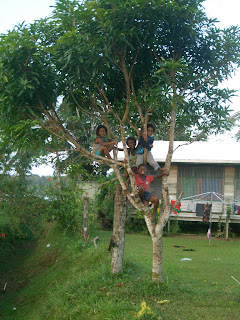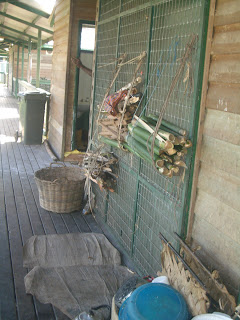Singing
Singing with Papua New Guineans is inspirational. This is fellowship meeting during the week at the hospital. All of the people are staff and family and they are singing in Pidgin. Enjoy!
Singing with Papua New Guineans is inspirational. This is fellowship meeting during the week at the hospital. All of the people are staff and family and they are singing in Pidgin. Enjoy!













This is what you do when you don't have TV, XBox or computer.


What a day again. Today I had a snakebite and he was envenomated and had all the neurotoxic affect. He had droopy eyelids, weak limbs, slurring of speech, double vision, drooling…etc… He presented to the hospital 10 hours after the bite. He first got to the nearest health center but they don't have antivenom so by the time he got on the canoe and got to Kikori Hospital it had been 10 hours after he was bitten. The snake was a death adder. Well we started the antivenom but he started developing an anaphylactic reaction with wheals, coughing, wheeze. Normally I would totally panic but because everytime I did anything with the patient, I begin with prayers with the staff and it really makes a difference even when things don’t go right. Well of course I had to give the adrenaline, steroids, antihistamine…etc… and eventually the reaction went down. The problem is that he needs the antivenom so even with the reaction, you have to restart the antivenom. That was hard and thank goodness after restarting, he did not react. Phew!!! He then stopped slurring and was able to speak somewhat clearly. So I knew he would be ok. While all of this was happening, there were four other admissions, an axe accident, a cachetic lady, and domestic violence. Well no one died and everything was under control by midnight. Praise God!!!
There is no concept of saving or planning for the Papua New Guineans. Mode of life is survival here in Kikori. Some of them don't even know what they will be eating that day. The coastal area (Kikori) are more hunter gatherers. I am told in the mountains, they plant and have gardens so most of the fruits and vegetables comes from the highlands. When they have found more than they can eat, they bring it to the market sometimes to sell it. The money they make, they can buy other items at the market or go to the store. There is a dismal store in Kikori. I will post a picture of the store some other time.








There are so many patients with Tuberculosis at the hospital. They all stay for 2 months to complete their intensive treatment. After the two months, hopefully with the routine, they will be compliant and continue another 4 months of TB treatment at home. So far the TB treatment seems to be working so no resistant yet in PNG. In the short time I've been here, I've seen all forms of TB--lung, spine, joint, lymph nodes, abdomen...etc.... Here are pictures of some of the obvious ones. They still present quite late. The problem is they keep coming back because the primary case prob the coughing grandmother or grandfather is still at home. So once they're treated, they go home and get infected again, or later their siblings gets admitted. So we're trying to do contact tracing but it's hard as some of them live in villages far away and it's difficult to get them to come to the hospital for a review. I belive the TB problem with get worse. And if resistant arrives as it has done in Africa already, and with the increase of HIV, it can become a very serious problem.


 Above is a picture of a healed TB of the Spine (Pott's disease). There is a hump which she has to live for the rest of her life. At least it's healed and she can walk and there are no more symptoms.
Above is a picture of a healed TB of the Spine (Pott's disease). There is a hump which she has to live for the rest of her life. At least it's healed and she can walk and there are no more symptoms.
A 4 year old boy presented with a 2 days history of strangulated hernia (part of the bowel protruding through a small opening out of the abdominal cavity, if it;s so small, the bowel cannot get back into the abdominal cavity and therefore lose blood supply and part of the bowel could die. He came by canoe costing the family their savings 240kina which is about £35 pounds for the petrol for the canoe. It took them 6 hours on canoe. When we saw him he had a swollen, red, tender hernia which basically means he needs to be seen by the surgeon now!! if he presented in A&E in UK. As it was two days that he has had it, it may mean that the bowel had already died. There's a trick to reducing hernia I have learned, which is pulling the hernia (of course once again using the amazing ketamine anaesthetic to put the child asleep so he will not scream and fidget), then the content of the bowel slowly drains away and slowly by slowly the bowel goes through the small opening and so the hernia is reduced. It still means he needs surgery to close the opening as he has risk of the bowel coming through the opening again. Well luckily this time the hernia was reduced, it was not red or painful anymore. As I said the family has already used all their savings to get to Kikori, so there is no way they have money to go to the capital general hospital to get the surgery. This is where the oil company comes in handy. After discussing with the doctor there, they agreed that the risk is high and he should be transported to Port Moresby. They will pay for the return plane ticket to Port Moresby. Praise God! And I was so happy to see him have a bowel movement the next day (which means part of that bowel had not died).
A 2 year old girl came in at about 9pm at night while I was trying to reduce another child's forearm fracture. Her mother said she has not been using her left arm. Her left arm was just hanging there-motionless. She was pushed over by an older child and landed on her left side. Even though history does not suggest a pulled elbow it was the way it looked and on palpation of her whole arm, she was not in pain at all. I hadn’t done Emergency as part of my rotation and I have no idea how to fix it. So I had to go to the books. Since it was 9pm that night and I don't know how to fix it, I sent them home and told them to return in the morning. There’s a really good surgical book that a friend had recommended to bring ‘Primary Surgery’ and sure enough, it had great instructions and pictures. That's what I do a lot of the time. I read during my free time, not leisurely books but medical books. I read up on how to reduce fractures, what to do in obstetrics emergencies, and I do that all before bedtime as that is the only time I have. The power goes off around 10pm so after a shower, I wear my headtorch and get to reading. The next morning, mom and child turned up. I practiced first on one of the nurses and then I attempted on the child to put that elbow back. I had to try twice because I wasn’t sure if it worked the first time. There was no click and I didn't feel anything. The child didn’t cry at all. The next minute she gave me this huge smile and started moving her arm. It was the most beautiful smile and she made my day!








It has been very busy-- Lots of interesting cases. I cannot believe the things that I’m doing such as reducing fractures, putting cast on, doing xrays including developing the xray films in the darkroom and ultrasounds (there is a portable ultrasound in the size of a large laptop). I’m even giving anaesthetic to reduce fractures or to do incision and drainage or debridement. A month ago I would have said you’re mad. The anaesthetic I use here is IV Ketamine. It’s one of those anaesthetic drugs that I only read and heard of during medical school. That is no longer used in western world. It’s quite an effective anaesthetic. The only nasty thing is they don’t close their eyes, and they have this glassy eye look and sometimes they get bad reaction when they get up from the anaesthetic--they can get hallucinations. So far everything has been good. No one has reacted badly. One 8 year old girl got up making jokes and was quite funny really. She had a difficult rare fracture and I tried as much as I could to try to reduce it. There’s a couple of difficult fractures. Another one is a 15 year old girl with a femoral (thigh bone) fracture. We really need a Steinman pin to give her traction but we have no Steinman pin here and so we are using skin traction. All my non medical friends, sorry for this sort of boring information but my medical friends would appreciate it.

